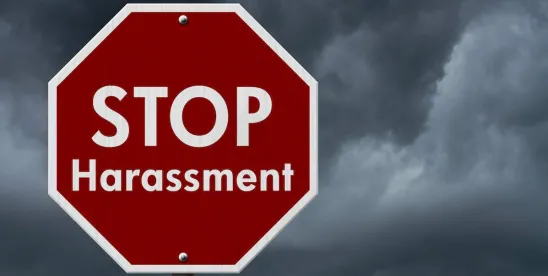In June 2024, the Equal Employment Opportunity Commission (EEOC) issued guidance tailored to the construction industry concerning harassment in the workplace or at the jobsite. The guidance is important for construction industry leaders and employers to understand how to prevent and remedy harassment in the workplace — more than a third of all EEOC discrimination charges filed between 2019 and 2023 asserted harassment. The guidance represents the EEOC’s latest effort in executing its Strategic Enforcement Plan for Fiscal Years 2024 to 2028, which, in part, focuses on combatting systemic harassment and eliminating barriers in recruitment and hiring, particularly for underrepresented groups in certain industries, including women in construction, through the EEOC’s enforcement efforts. In this article, we highlight key principles and practices from this guidance
Leadership and Accountability
The guidance reiterates that consistent and demonstrated leadership is critical to creating and maintaining a workplace culture where harassment is unacceptable and strictly prohibited. Worksite leaders, including project owners, crew supervisors, and union stewards, are each expected to regularly communicate that harassment is intolerable through several suggested efforts.
Project owners and general contractors, who play a vital role in oversight and project execution, are expected to be leaders in creating a culture of collaboration and professionalism. General contractors are expected to share critical information regarding their expectations of a harassment-free workplace with subcontractors and to refer those who may require assistance complying with anti-discrimination and harassment laws to the EEOC’s various resources for employers. To that end, the EEOC recommends that anti-harassment policies be included in contractor bids for projects and in agreements between general contractors and subcontractors so that clear expectations of a harassment-free jobsite are set before a project begins.
General contractors are encouraged to engage in the following harassment-prevention measures:
- Determine the scope and substance of training for the project.
- Monitor and enforce subcontractor compliance with anti-harassment policies.
- If applicable, coordinate with unions, tradeswomen organizations, and apprenticeship programs to form a committee tasked with identifying and preventing harassment and collaborating to develop solutions.
- Verify that subcontractors are implementing and enforcing anti-harassment policies and monitoring the effectiveness of subcontractor efforts to mitigate harassment.
- Assist subcontractors in addressing and finding solutions to harassment concerns, especially when harassment occurs between workers from different employers.
- When circumstances warrant, work with a subcontractor’s management or site supervision team to remove harassers from the worksite.
- As appropriate, acknowledge and thank workers for preventing or addressing workplace harassment on behalf of themselves or others.
General contractors are also encouraged to solicit and share feedback (including through anonymous surveys) from workers at the jobsite regarding the efficacy of the collective anti-harassment effort to remedy shortcomings or reiterate expectations.
Comprehensive and Clear Harassment Policies
The guidance recommends that robust and clear anti-harassment policies be prepared with input by the supervisors and managers responsible for implementing them. Employers in the construction industry should also consider soliciting feedback from workers at all levels to ensure that the policies are clear and understandable, that policies are consistent with workers’ native languages, and that they routinely communicate about the relevant policies. Such policies should be accessible and posted in a central and accessible location. The EEOC also encourages general contractors to make their own anti-harassment policies or a model policy available for subcontractors to adopt.
An Effective and Accessible Harassment Complaint System
Generally, the complaint procedure is a crucial aspect of any harassment policy. The EEOC recognizes the complexity of a multiple employer/entity environment that is typical in the construction industry and recommends that while each onsite employer may have its own complaint reporting procedure, the general contractor of the construction project should make supplemental complaint channels available for all workers regardless of their employer of record. Further, general contractors should coordinate such complaint procedures across projects and subcontractors. The EEOC guidance includes several best practices about complaint procedures.
Effective Harassment Training
In its guidance, the EEOC recommends that comprehensive, interactive, and live (if possible) anti-harassment training be provided to all workers with input from jobsite leaders and other workers at various project seniority levels to ensure that the training is tailored to the workforce and the dynamics of the worksite. The guidance suggests that the training include industry-specific topics, examples, and risk factors in the construction industry.
Construction Industry Harassment Risk Factors
The EEOC’s guidance identifies certain construction industry risk factors and provides that employers should remain extra vigilant of potential harassment as a result:
- A homogenous workforce (e.g., it states that women comprise just 11% of the construction workforce even though they represent 47% of the labor force. African American workers made up nearly 13% of the labor force in 2023 but represented less than 7% of the construction workforce).
- Pressure to conform to traditional stereotypes.
- Decentralized workplaces.
- Worksites with multiple employers present.
- The cyclical, project-based work of the construction industry.
The issuance of this guidance may signal an increase in the EEOC’s enforcement efforts in the construction industry. Therefore, employers in the construction industry should consider reviewing the principles and best practices in the guidance in comparison to their own policies and practices and implementing changes with the assistance of competent counsel.




 />i
/>i

